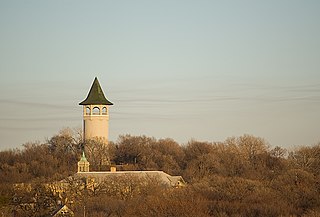
Prospect Park is a historic neighborhood within the University community of the U.S. city of Minneapolis, Minnesota. The area is bounded by the Mississippi River to the south, the City of Saint Paul, Minnesota to the east, the Burlington Northern railroad yard to the north, and the Stadium Village commercial district of the University of Minnesota to the west. The neighborhood is composed of several districts which include the East River Road area. The 1913 Prospect Park Water Tower is a landmark and neighborhood icon.
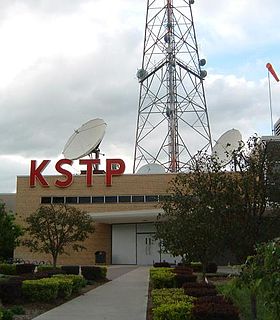
University Avenue is a street that runs through both Minneapolis and Saint Paul, Minnesota. It begins near the Minnesota State Capitol in Saint Paul and extends westward into neighboring Minneapolis, where it passes the University of Minnesota, and then turns north to pass through several suburbs before its main portion ends in Blaine, Minnesota, although there are stretches of road designated as University Avenue that are north of the Blaine terminus, the final stretch ending near Andree, Minnesota. For many years, the road carried U.S. Highway 12 and U.S. Highway 52, and University Avenue is still a significant thoroughfare in the area.

Highland Park is a neighborhood in the southwestern corner of Saint Paul, Minnesota, United States. Also known as Highland District Council, it lies along the Mississippi River just north of Fort Snelling and across the river from Minneapolis–Saint Paul International Airport. According to the 2000 census Highland Park had a population of 23,202.
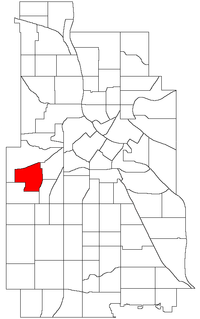
Kenwood is a neighborhood within the Calhoun-Isles community in Minneapolis. Its boundaries are Cedar Lake Parkway to the west, Kenwood Parkway to the north, West Lake of the Isles Parkway to the east, and Kenilworth Place to the south. The neighborhood is one of the most affluent in the city, with mansions along the parkways.

Cedar-Isles-Dean is a neighborhood in the Calhoun-Isles community in Minneapolis. Its boundaries are the Kenilworth Lagoon and Lake of the Isles to the north and east, West Lake Street to the south, and France Avenue South to the west. Nearby neighborhoods include Bryn Mawr and Kenwood to the north, East Isles to the east, East Calhoun to the southwest, and West Calhoun to the south. To the west is the suburb of Saint Louis Park. The neighborhood, one of the most affluent in the city, takes its name from Cedar Lake, Lake of the Isles, and Dean Parkway.

White Castle Building Number 8 is a former White Castle restaurant building in Minneapolis, Minnesota, United States. It was one of the few prefabricated, portable buildings built by the chain, and is now operated as an antique/vintage goods shop.

The Washburn Park Water Tower poses as a landmark of early 20th-Century architectural achievement within the Tangletown neighborhood in south Minneapolis, Minnesota, and has been doing so for nearly 75 years. Perched on top of one of the highest points in south Minneapolis, the tower is given the privilege to boast its unique location and role as an unofficial "beacon" for incoming planes landing at Minneapolis-Saint Paul International Airport, yet remains hidden from much of the residents and visitors that pass by the base of the hill each day. This is mainly because large homes and tall oak trees scatter the hillside where the tower resides, and even more so, because of the clustered mess of streets and dead ends that compromise the towers' occupancy. Hence the name, 'Tangletown'.

Minneapolis is the largest city by population in the U.S. state of Minnesota, and the county seat of Hennepin County. The origin and growth of the city was spurred by the proximity of Fort Snelling, the first major United States military presence in the area, and by its location on Saint Anthony Falls, which provided power for sawmills and flour mills.

Our Lady of Lourdes Catholic Church is a Roman Catholic parish church of the Archdiocese of Saint Paul and Minneapolis located in Minneapolis, Minnesota in the United States. It was built on the east bank of the Mississippi River in today's Nicollet Island/East Bank neighborhood; it is the oldest continuously used church building in the city and is part of the St. Anthony Falls Historic District.
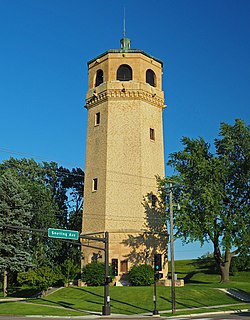
The Highland Park Water Tower is a water tower in the Highland Park area of Saint Paul, Minnesota, United States. It was designed by Clarence W. Wigington, the nation's first African-American municipal architect. The tower was listed on the National Register of Historic Places in 1986. It was completed in 1928 at a cost of $69,483.

The former First Church of Christ, Scientist, located at 614-620 15th Street, East, in the residential neighborhood of Elliott Park, in Minneapolis, Minnesota, United States. was the first Christian Science church building in Minnesota. It was once surrounded by Victorian homes, but most of them have been replaced by apartment buildings. Minneapolis architect S. J. Bowler designed the building in the Doric order. The facade of the building features a deep portico with two fluted columns holding up a pedimented gable.
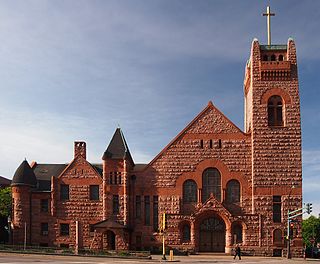
The Wesley United Methodist Church building was constructed of granite, stone, brick, and sandstone in Richardsonian Romanesque style, featuring round-arched windows and multiple towers. When built, the building was in the residential neighborhood of Loring Park at 101 Grant Street East; it was built during Minneapolis' building boom in the last decade of the 19th century. Architect Warren H. Hayes (1847–1899) was Minneapolis' leading designer of churches in the 19th century, having designed the Calvary Baptist Church, Fowler Methodist Episcopal Church, and the First Congregational Church, as well as the Central Presbyterian Church in Saint Paul. Today the location is overwhelmed by the neighboring Minneapolis Convention Center.
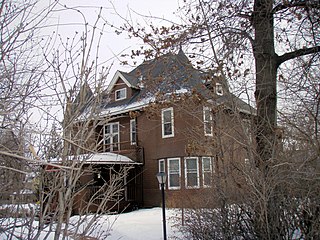
Harry Wild Jones was a popular Minneapolis, Minnesota-based architect who designed throughout the country and the world. Born two years before the start of the American Civil War, Jones, a twelfth generation New Englander, took his place on the American architectural stage in the late 19th century. His life spanned seventy-six dynamic years, during a period of U.S. history that matched his exuberant, spirited personality. Known as an architect adept at any design technique, Jones is credited with introducing Shingle Style architecture to Minneapolis. He created an impressive portfolio from neoclassic to eclectic, reflecting his unique brand of versatility and creativity.

Gold Medal Park is a 7.5-acre (3.0 ha) park in the Downtown East neighborhood of Minneapolis, Minnesota, United States. Opened in May 2007, the park was designed by landscape architect Tom Oslund and is owned by the city of Minneapolis. It takes its inspiration from the Native American mounds that are found throughout Minnesota, and its name from Gold Medal flour, a product of General Mills. It consists of a 32-foot-high (9.8 m) mound, reached by a spiral walkway rising out of a green lawn with 300 trees. The park, just east of the Guthrie Theater, provides the Mill District neighborhood with some rare green space.

The Scottish Rite Temple, formerly the Fowler Methodist Episcopal Church, is a historic church building in the Lowry Hill neighborhood of Minneapolis, Minnesota, United States. It was designed by architects Warren H. Hayes and Harry Wild Jones. The original portion, the rear chapel, was designed by Warren H. Hayes and built in 1894. When the congregation expanded and more funds were available, Harry Wild Jones designed an addition that expanded it to a much larger structure. This was completed in 1906.

The Elisha and Lizzie Morse Jr. House is a house in the Whittier neighborhood of Minneapolis, Minnesota, United States, listed on the National Register of Historic Places. The house is designed in the Italian Villa style. Its most distinctive feature is the cupola with shallow arches over paired windows. The siding is also a unique design. The planks were made to look like cut stone by cutting incisions at regular intervals, then painting the siding with a mixture of paint and sand. This technique was rarely practiced in Minnesota architecture, and there are few surviving buildings with this treatment.

Frederick William Cappelen was a Norwegian-born architect and civil engineer who held the office of Minneapolis City Engineer.

Mill City Museum is a Minnesota Historical Society museum in Minneapolis. It opened in 2003 built in the ruins of the Washburn "A" Mill next to Mill Ruins Park on the banks of the Mississippi River. The museum focuses on the founding and growth of Minneapolis, especially flour milling and the other industries that used hydropower from Saint Anthony Falls.

The Hollywood Theater is a historic theater building in Minneapolis, Minnesota, United States, which is listed on the U.S. National Register of Historic Places. The Art Deco theater building opened on October 26, 1935, and the marquee proclaimed it the "Incomparable Showcase of the Northwest". The theater, designed by architects Jack Liebenberg and Seeman Kaplan, had a generous budget that allowed for elaborate decoration in the Streamline Deco style of design; its facade and structure made a "powerful statement of geometric mass punctuated by the entrance, exits, and three small windows that served the projection booth." Liebenberg and Kaplan went on to design the Riverview Theatre in Minneapolis and the Terrace Theatre in Robbinsdale. The building featured a tall vertical sign, a patterned terrazzo floor, gilded pillars, and acoustical tiles in geometric patterns. It had a seating capacity of just under 1000. Much of the interior features are influenced by the Zig-Zag Moderne and Streamline Moderne styles. The exterior is built of smooth Kasota limestone with vertical lines that transition to horizontal.

The Prospect Park Water Tower, sometimes referred to as the Witch's Hat Water Tower, is a historic water tower in the Prospect Park neighborhood of Minneapolis, Minnesota, United States. It was built in 1913 on Tower Hill Park, a hilltop park established in 1906. The water tower has become the neighborhood's architectural mascot for its singular design by Frederick William Cappelen. The tower is rumored to be the inspiration for Bob Dylan's song "All Along the Watchtower," as the tower was clearly visible from Dylan's home in nearby Dinkytown.





















